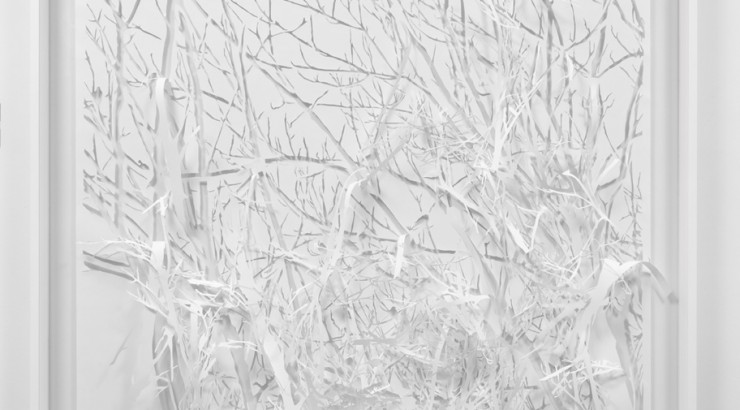
The Art of Writing about Art Part 5: Soo Kim
November 13, 2015
For the final post in The Art of Writing about Art series we turn to the newest work to enter the Escalette Collection: Soo Kim’s hand-cut paper That was because this year will of course go on (2014). Like Mary Corse’s Untitled, with which we began, Kim’s relief sculpture in paper is a study in white, a monochromatic exploration of what can be achieved with light and shadow. Elise Jacobsen (Freshman, undeclared) and Lauren Yamin (Freshman, TV writing and production) considered the balance of simplicity and complexity that is one of the strengths of Kim’s work.
In Jacobsen’s reading, “[t]he scene seems to be one of peace and tranquility, a forest on a winter day emerging into spring.” The work is an exploration of subtle transitions. “The composition seems haphazard at first glance, but though the branches are tangled together without order, they thin out towards to top, and pile over each other in the bottom half, creating increasing density. Kim uses light and shadow to add to that depth, as the negative branches seem to be a darker grey against the white, while the positive branches are even brighter, catching the light in the foreground. Thus, light seems to be descending from the upper, less dense half, down through the branches. Her use of light and shadow to develop this effect creates a sense of serenity. Moreover, the lack of color does not make the work dull, but rather removes distractions. The tangled branches strewn throughout seem to form a cohesive whole, united by the uniformity of the absence of color.
Indeed, the uniformity of the shades of white in That was because this year will of course go on creates a calm mood, one of quiet expectation. The white is evocative of a winter forest, with trees covered in quietly sparkling snow, while the details of small birds perched on various branches seem to herald a coming spring. Often winter is seen as a period of desolation, while spring is the time of rebirth. The phrasing of the title, especially “of course” seems to imply that there had been a doubt that the year would go on, that there was a chance they could have been stuck in the desolate winter. The birds, along with the tranquility of the white landscape, then seem to be a symbol of hope for a new year, creating a winter scene viewed fondly, not with fear or apprehension.”
Yamin draws attention to the importance of the medium itself, the “plumes of paper strips,” as suggestive of a environmental-moral message. “Each cut is clean and the original white and smooth quality of the paper is not altered in any way,” giving That was because this year will of course go on an unexpected “rawness.”
“The simplicity adds an element of purity, where the material is manipulated to emphasize the fragile nature of the paper, tying the medium back to its original place in the natural world. With thin cutouts dangling precariously from their small anchors to the page, the scraps introduce the natural force of gravity. This gives the work a new form of three dimensional shape and a weightless mass, perpetually drifting off of the page. In doing so, the artist introduces a kind of realism, drawing attention to the origin of the material.
While representing the branches of a tree, Kim makes a tribute to the source from which the medium came: trees. By choosing a subject that relates to the material used, as well as skillfully preserving the paper scraps from the cutting, Kim seamlessly ties together the current piece with the ancestry behind its creation. The natural purity of the piece is directly related to the impression it offers, a tie back to the roots from which it was made. By paying tribute to the resources that allow art to be created, it gets one thinking about how humanity treats the world that offers the opportunity of civilization.”
With Kim’s That was because this year will of course go on we thus end with the promise of new beginnings, and with the question of what we, as individuals and as a collective, will do with the world that is in our care.


